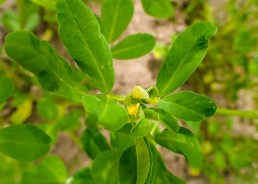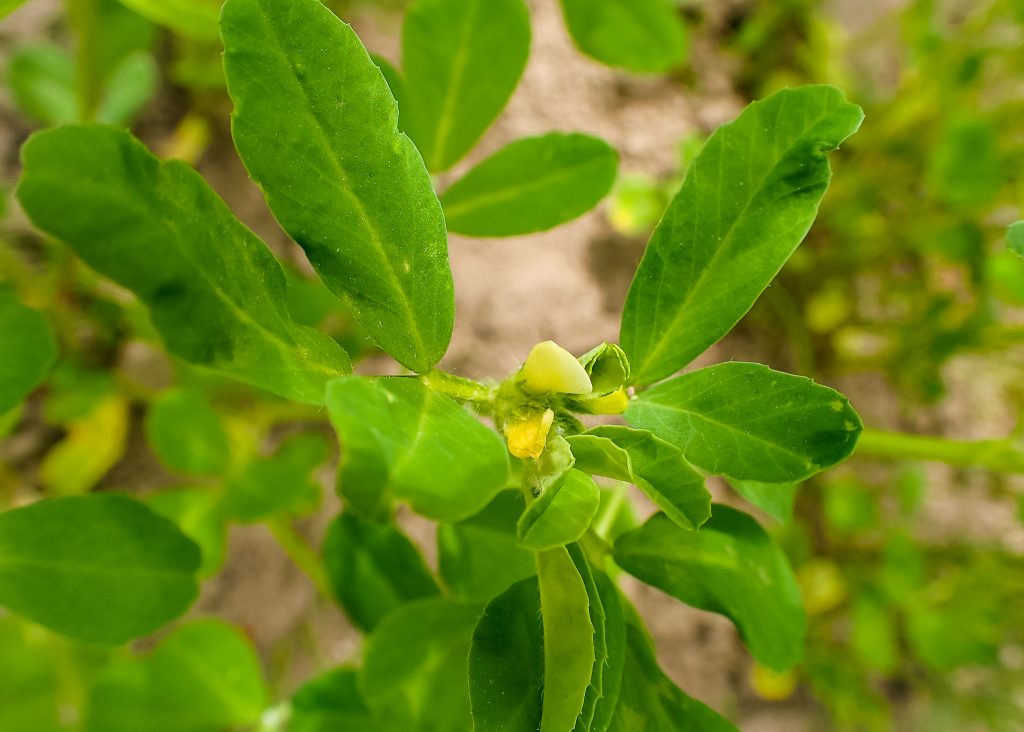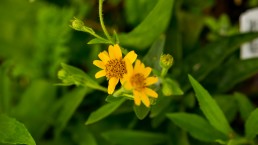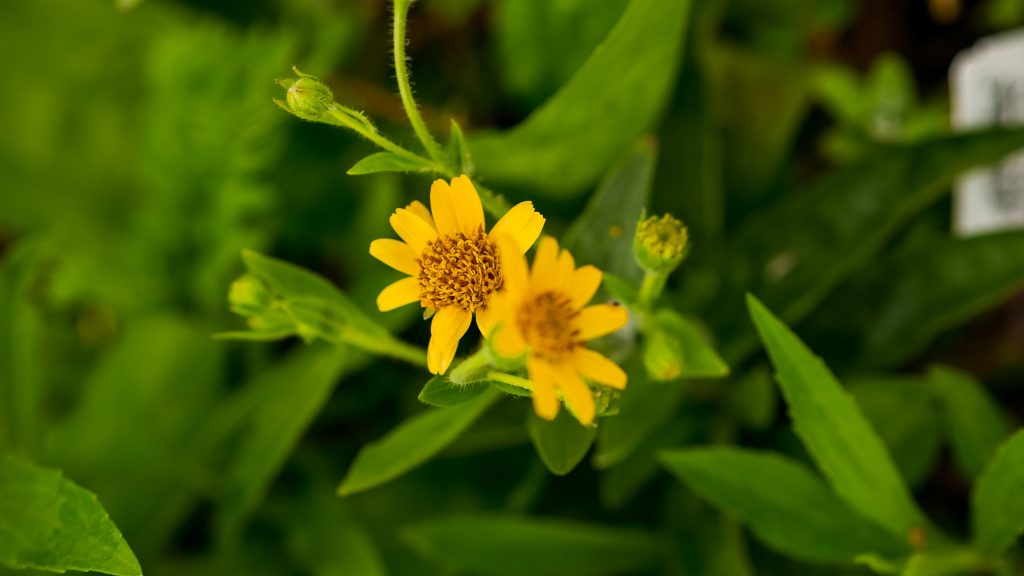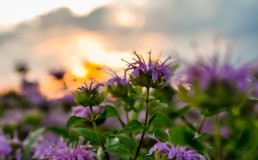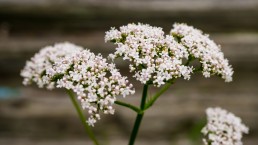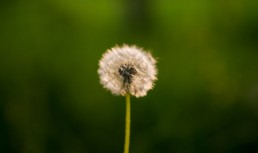Fenugreek: Materia Medica
Trigonella foenum-graecum
Fenugreek is an herb with a long and esteemed history both in medicine and the culinary arts. Some authors suggest that fenugreek originated in India and North Africa, while others suggest that it is indigenous to the eastern Mediterranean region. One of the earliest recorded uses of Fenugreek comes to us by way of Egypt, where it was used in incense making as well as in the process of embalming mummies. Fenugreek, as the name suggests, was widely utilized by the ancient Greeks, for whom it was a staple food. The name foenum-graecum, which literally translates as ‘Greek hay’, refers to the practice of mixing fenugreek with inferior quality hay in order to increase and enhance its scent.
Nutritional and Medicinal Value
As part of its nutritional profile, fenugreek contains considerable amounts of vitamin B and phosphorous compounds (e.g. lecithin), making it a culinary herb with a special affinity for the nervous system (lecithin is a mixture of neutral lipids and phospholipids, which are important constituents of the central nervous system and play a role in promoting and maintaining the health of the brain’s functional pathways). Fenugreek is often added to curries, where it serves to aid and promote healthy digestive function but also helps to prevent gas, bloating, cramping, indigestion, heartburn, and acid reflux in susceptible individuals. Fenugreek contains considerable amounts of iron, and may be well employed in some cases of iron-deficiency anemia: fenugreek helps the body in the process of blood formation. Continuing with the nutritional properties of the herb, Dorothy Hall remarks: “As it also manufactures in its growth vitamin A and a vegetable-form of vitamin D, it is supportive of liver function too, and protective of all mucous-lined body organs. There is much sulphur present; and also choline, and support for cholesterol metabolism” (Hall: 1988, 159). Fenugreek is an herb to consider when dealing with a hypo-functioning liver. In Ayurvedic medicine, fenugreek is recognized as “a good herbal food for convalescence and debility, particularly that of the nervous, respiratory and reproductive systems” (Frawley & Lad: 2001, 190)
Concerning the use of fenugreek as a medicinal herb, Hall provides us with the following overview:
“Its properties may best be summed up as supportive of liver function, protective to mucous- linings all through the body, and giving renewed nervous energy. There is a fourth benefit, however, and one which is becoming more and more necessary today: Fenugreek clears and promotes the drainage of the body by the lymphatic system. As lymphatic vessels and lymph- fluid movement are essential parts of our immune system, Fenugreek may become a valuable plant for the future.” (Hall: 1988, 159)
Fenugreek is likely the most frequently employed herbal galactagogue, meaning that it helps to promote the production of breast milk. It is also widely used in the treatment of diabetes type 1 and 2, where it helps to increase the body’s tolerance for carbohydrates, reduces blood sugar and total LDL cholesterol levels. Fenugreek can be used by men who experience seminal debility (i.e. issues with the quality and quantity of sperm), as well as for erectile dysfunction and low libido (fenugreek contains furostanolic saponins, which have been linked to increased testosterone production). Fenugreek is a lung tonic and has its place in the treatment of asthmatic complaints, as well as lung and sinus congestion. A paste made from fenugreek seeds can be used topically for ailments such as boils, ulcers, burns, and poorly healing sores (Frawley & Lad: 2001, 191). Other traditional indications include: tuberculosis, gout, and generalized body pain.
On the level of herbal energetics, fenugreek is: bitter, pungent, sweet/heating/pungent. It affects the plasma, blood, marrow, nerve and reproductive tissues and has an affinity for the digestive, respiratory, urinary, and reproductive systems (Frawley & Lad: 2001, 191). Fenugreek is a stimulant, especially for a slow-draining lymphatic system and where there are issues with edema and fluid retention. Fenugreek possesses diaphoretic and mild diuretic actions. It also possesses tonic, expectorant, rejuvenative, and aphrodisiac properties.
Works Cited:
Hall, Dorothy. Dorothy Hall’s Herbal Medicine. Melbourne: Lothian Publishing Company, 1988.
Frawley, David & Lad, Vasant. The Yoga of Herbs. Wisconsin: Lotus Press, 2001.
—-
Image Credits:
Krzysztof Ziarnek, Kenraiz: Mildly colour edited version of their original Fenugreek image.
Arnica: Materia Medica
Arnica and its Application
Arnica is an herb with a “strange history”, as herbalist Rudolf Weiss comments,
“It used to be very popular, being used internally as well as externally. It is said that the German writer, poet and scientist Goethe would ask for Arnica tea when in his old age he experienced anginal pain due to coronary arteriosclerosis” (Weiss: 1994, 169).
In fact, Goethe claimed that Arnica had saved his life. He sang the praises of Arnica, holding it up as an archetypal healing herb with associations to Helios (the all-knowing God of the sun, of prophecy, and of healing) and Asclepias (son of Helios, the caduceus wielding God of medicine, healing, and rejuvenation who oversees physicians and the practice of the healing arts amongst human beings). Goethe writes:
“Thus I assign Arnica to Helios among the gods. And among men? To the follower of Asclepias who wanders among the lonely heights. Here we have a plant of rapid healing, of firm decision. If you suffer violence and injury, from fist, cudgel or blade, wondrous healing is nigh in this herb. The vital energies are flowing, the pulse grows stronger, the heart takes courage; if the blood has lost its way in a bruise or an effusion, arnica will remind it of its proper courses. Muscles and sinews grow firm; the body form, having suffered insult and injury, is restored, and so is the nervous system where it is so difficult to achieve healing. The organic revolt at injury sustained — we call it pain — lessens and passes.”1
Topical Verses Internal Use
Despite Goethe’s praises, most contemporary authors and practitioners of herbal medicine warn of the dangers of the internal use of Arnica, though it is still widely used topically. The chief indications for the topical use of Arnica include bruises which have resulted from a fall, a blow, or other accidents, as well as poorly healing wounds and leg ulcers.
Weiss notes a traditional use of Arnica tea or tincture (5-10 drops per cup of water) as a gargle to treat sore throat and pharyngitis. “This was found to be most effective with chronic conditions where the circulation was poor in the pharyngeal region, particularly chronic granular pharyngitis, and for chronic smoker’s cough, giving symptomatic relief” (Weiss: 1994, 170).
Arnica provides some of its greatest curative effects in patients who suffer from poor circulation, given its special affinity for the vascular system. In this respect, Arnica covers some of the same clinical indications as does Hawthorn, specifically “senile hearts and coronary artery disease with or without angina” (ibid). Both Arnica and Hawthorn serve to improve the blood supply through the vessels of the coronary artery, though Arnica exerts a pronounced stimulating action in this region and as such is indicated in acute conditions, such as acute weakness of the heart, whereas Hawthorn is better suited for long-term use in chronic cardiovascular conditions such as coronary artery disease, atherosclerosis, and congestive heart failure.
In this author’s opinion, Arnica can and should be used internally by clinical herbalists who have been carefully instructed with respect to its specific indications and proper posology. The risks of the internal use of Arnica include gastric irritation, intoxication with dizziness, tremor, tachycardia, arrhythmia, and collapse (ibid). This is to emphasize the importance of working with a well-trained herbalist, especially when it comes to herbs that carry the potential for adverse events.
Arnica in Homeopathy
To further understand the healing actions of Arnica, let us turn now to homeopathy. Arnica is a very well-known and widely utilized remedy in homeopathic medicine. As in herbal medicine, Arnica is recognized in homeopathy as a remedy that has strong associations with physical trauma and is widely used in the treatment of acute injuries as well as chronic conditions that have resulted as a consequence of a blow, a fall, or some other significant affliction. Examples of such chronic conditions resulting from a significant injury can include: post-traumatic arthritis, neurological damage (e.g. post concussive syndrome), or even a variety of psycho-emotional and cognitive disturbances, such as depression, irritability, uneasiness, and nervous sensitivity. Arnica treats the effects of shock and trauma that have become impressed on the central nervous system.
Arnica, as noted in the above herbal indications, has a strong association with bruising, and is often called upon to help with the reabsorption of blood after surgery. It is always important to treat bruises: bruises create a condition that we can describe as ‘bad blood’, ‘stagnant blood’, or ‘congealed blood.’ This can, in turn, lead to cancerous conditions in the distant future. Put otherwise, where there are bruises on the body, the oxygen supply in the bloodstream to the affected area is compromised. Limited oxygen supply promotes the development and growth of tumours.
Homeopathic medicines are prescribed on the basis of the totality of a patient’s symptomatology, including the mental-emotional and even spiritual levels. The mental-emotional picture of the Arnica patient is someone who feels “bruised by life.” There can be a long history of emotional trauma and a life path that is characterized by difficult knocks and hard falls. This in turn results in a melancholic, morose, and withdrawn disposition. The Arnica patient can come off as standoffish and distant, as someone who dwells on their suffering and wants to be left alone with their pain. They may also be very obstinate and headstrong, unwilling to listen to the opinions and feelings of others. Arnica patients can feel at odds with the world, convinced that it is their fate to always be facing seemingly insurmountable obstacles. Such a patient may have a fear of being touched, and a fear of others approaching, lest she be touched. There may be a fear of death, especially as a consequence of heart disease or a sudden heart attack (this fear may be especially amped up during the night). There can be frightful dreams of being buried alive, of black cats, and of death, nightmares that can startlingly wake the patient from sleep, and which may have commenced after an accident or injury. The Arnica patient can be easily startled as a consequence of prior shocks that have become deeply set in the nervous system. This history of being beaten down and emotionally battered can give rise to chronic rheumatic and arthritic complaints, as well as a variety of skin eruptions and other painful conditions of the skin.
Footnotes:
1 Johann Peter Eckermann, a close associate of Goethe’s towards the end of his life, recorded a detailed account of Goethe’s profound healing experience with arnica in his book ‘Conversations Of Goethe’ (Eckerman: 1998).
References and Recommended Titles:
-
Eckermann, Johann Peter. Conversations of Goethe. Massachusetts: Da Capo Press, 1998.
-
Morrison, Roger. Desktop Guide to Keynotes and Confirmatory Symptoms. Grass Valley: Hahnemann Clinic Publishing, 1993.
-
Sharma, Yubraj. Spiritual Bioenergetics of Homeopathic Materia Medica. London: Academy of Light Ltd., 2019.
-
Weiss, Rudolf. Herbal Medicine. Gothenberg: Ab Arcanum, 1994.
Photos Provided by Serena Mor
Chickweed: Materia Medica
Chickweed
Botanical name: Stellaria media
Pertinent Information on the Plant
- Skin irritations
- Eye inflammation (poultice for Glaucoma inflammation)
- Mild diuretic (increases urine flow)
- Kidney disorders
- Vulneraries
- Anti-microbials (destructive to microbes)
- Anti inflammatory
- Demulcent (soothing action on inflammation, especially of mucous membranes)
- Emollient (softens and soothes the skin)
- Anti rheumatic
- Alterative (blood purifier)
- Antipyretics (reduce or prevent fevers)
- Expectorant (facilitates removal of secretions)
- Antitussive (controlling or preventing cough)
- Psoriasis
- Eczema
- Acne
- Can be used as an ointment (combines especially well with marshmallow)
- Cuts and wounds
- Lungs
- Stomach
- Nutritive (rich in vitamins and minerals; a source of easily assimilated nutrients)
- High in calcium, potassium and iron
- Urinary tract infections
- Curbs obesity
Habitat and Growing area
- Native to Eurasia, especially anywhere moist cultivate soil
- Naturalized in North America
Extra Notes
- Chickweed is a remedy to use in times of transition. It supports a person in the first stages of grief, helping to assimilate a situation that is unexpected or where the circumstances are unforeseen. It is gentle and unassuming, yet surprisingly strong and insistent.
(Photos of Giant Chickweed)
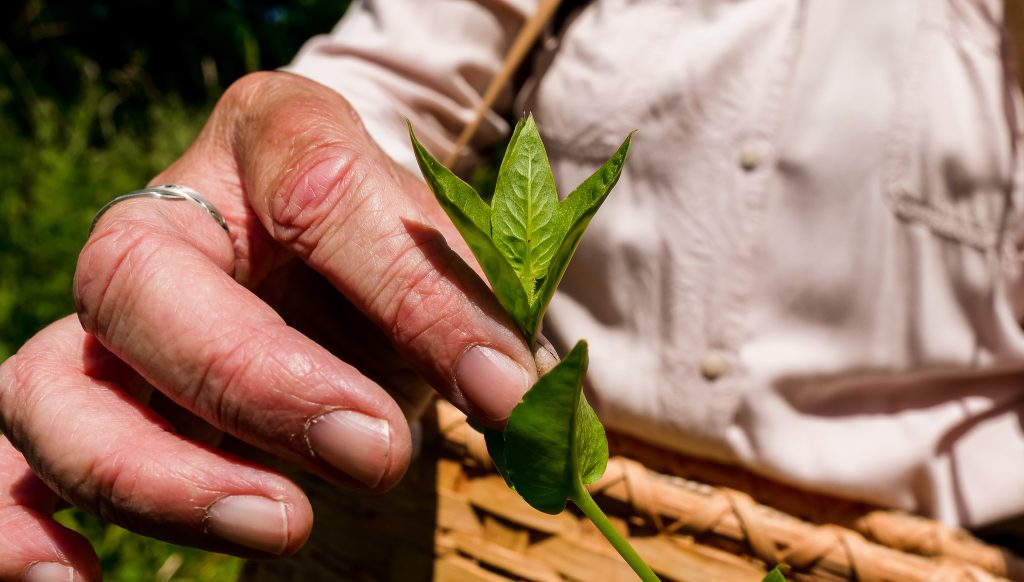
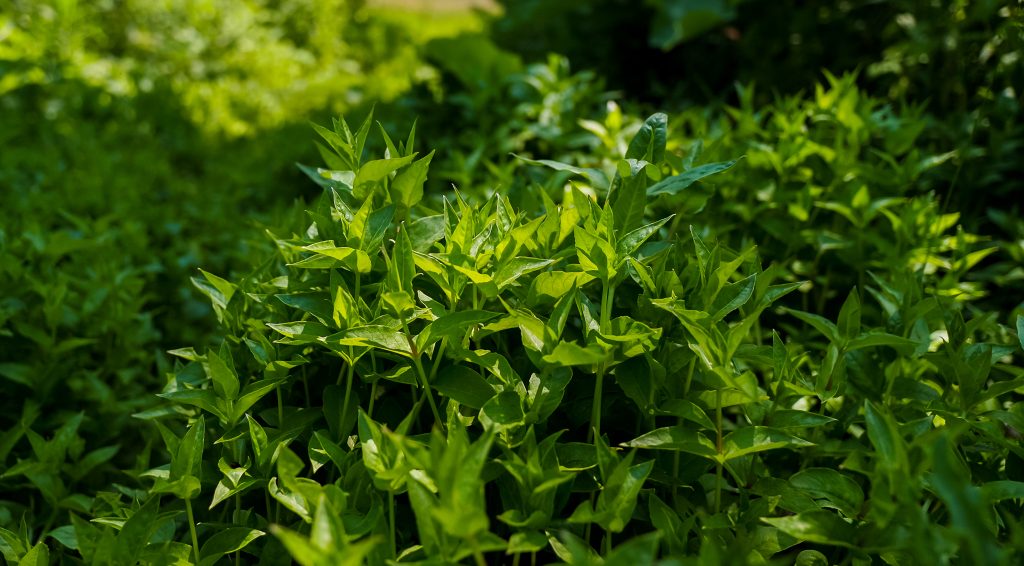
Reference Books:
Holistic Herbal, by David Hoffmann
Pages: 77-79, 138, 145, 160, 177, 191, 242
The Way of Herbs, by Michael Tierra
Pages: 13, 33, 34, 35, 118, 119
The Complete Encyclopedia of Herbs, by Nico Vermeulen
Page: 299
Family Herbal, by Rosemary Gladstar
Pages: 19, 55, 100, 102, 103, 105, 227, 284, 303, 323
Peterson Field Guide: Easter/Central Medicinal Plants and Herbs, by Steven Foster and James A. Duke
Pages: 48, 49
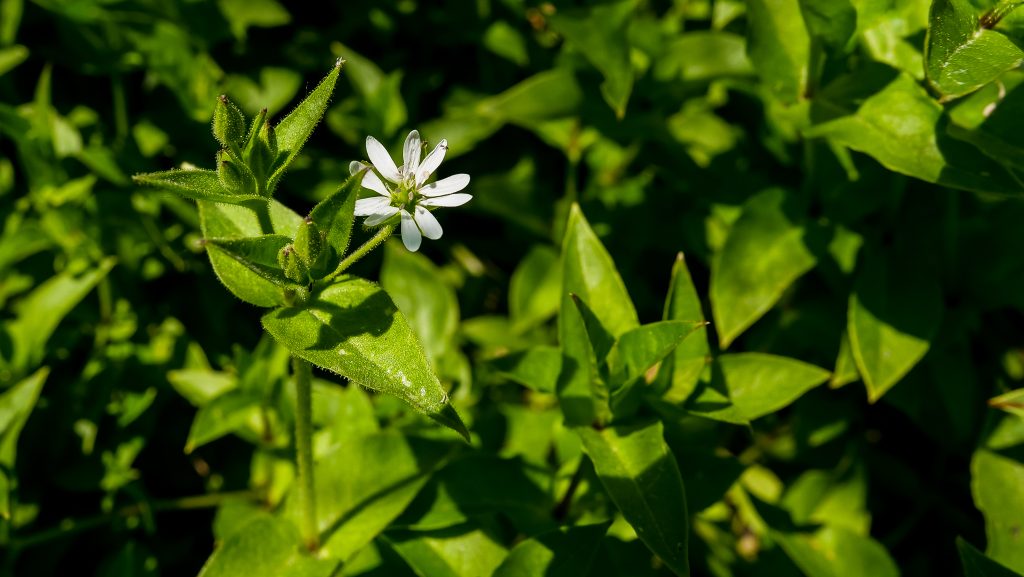
Learning Herbal Medicine: Wild Bergamot
Already longing for some summer-time herbs? Please enjoy this guest blog by Taylor Eveson discussing some of the medicinal uses and properties of Wild Bergamot!
Wild Bergamot
Scent: Aromatic and Pungent
Botanical name: Monarda fistulosa
Common names: Wild Bergamot, Sweet Leaf, Indian Perfume, Horsemint.
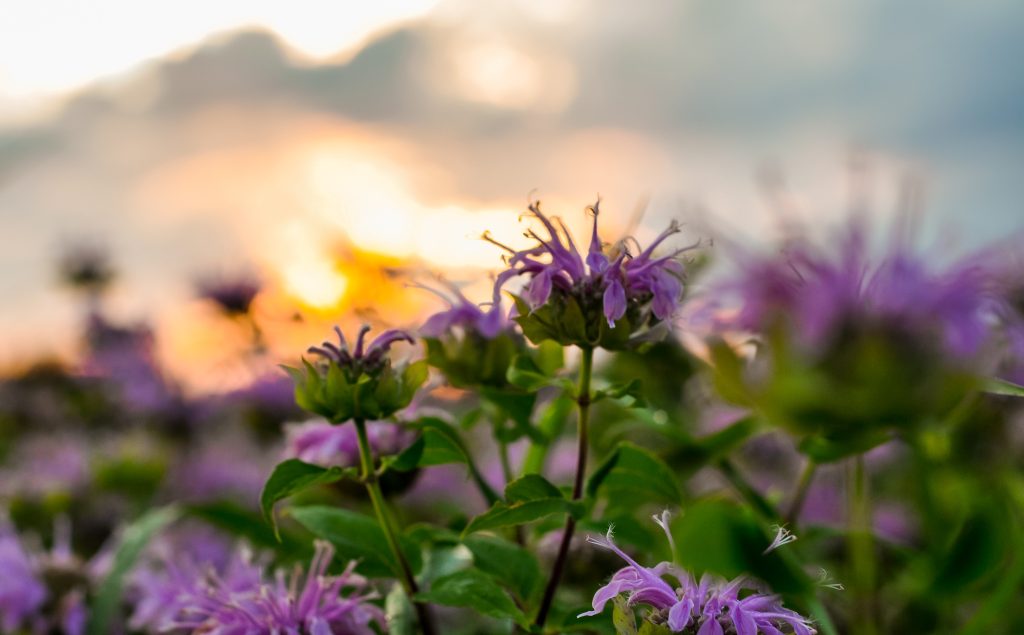
Identification
Wild bergamot is a perennial herb from the mint family. Like many other mints it has a square stem and opposite leaves. The leaves (5-8cm) are lanceolate with toothed margins and the bracts (the leaves just underneath the flowers) can be coloured with red or purple. Many stalks can sprout from the same root (known as a rhizome), so it is common to find several plants clustered together. It can grow to a height of almost a meter. From June to September it sprouts 20-50 flowers from the receptacle at the terminal end of the stalk. The tubular, irregular flowers can be varying shades of purple, lilac, pink or rarely white. The fruit is a nutlet, tightly clustered with many other nutlets. When the fruits ripen, they change colour from green to brown or black.
Habitat
It grows in rich, limey soils in dry fields, thickets and clearings. It prefers open fields and meadows that have not been cultivated for some time. It is distributed from Quebec to the Northwest Territories and British Columbia, and as far South as Georgia, Texas, Idaho and Northeast Washington. Some varieties are geographically widespread, but others are quite restricted to their range. Personally, I have been able to grow more than one variety of wild bergamot in a garden bed on a roof in Toronto; it did quite well as long as I watered it regularly.
Traditional Uses
Wild bergamot has many uses in traditional Native American culture. Due to its widespread distribution, many tribes utilized this plant including the Blackfoot, Cherokee, Chippewa, Cree, Iroquois, Ojibwa and Sioux nations. A Cherokee native, Tis Mal Crow, describes it as the medicine that draws out the fire, being particularly suited for burns and heat from fevers or infection. The Blackfoot applied a poultice of the flowers to burns or a burst boil, and after the wound was healed. Chippewa natives applied a poultice of crushed leaves to the head for headaches, and other tribes stuffed crushed leaves into the nostrils for the same purpose. Cherokee natives inhaled the steam from a hot infusion and also drank the tea for ‘sweating off’ flus and fevers.
In native American culture the concept of animal medicine archetypes is an interesting area of study. The indigenous people studied animals to learn about themselves and the medicines in their area. There were qualities about certain plants that merited an association to a particular animal; whether it was a favourite food of a particular animal, or some part of the plant bore physical resemblance to that animal, they recognized that the way animals related to plants contributed to why the animal was the way it was. So if they desired to attain to the nature of the bear or the deer, they would use the foods or medicines associated with that animal to achieve this end.
Wild bergamot is described as having a deer medicine animal signature. American herbalist Matthew Wood describes the plant as having long, slender stalks like a deer’s legs, supporting flowering heads that resemble a head with horns, or a rack of antlers. You can find the plant growing where deer like to graze near the edge of a forest, where they can quickly find cover if they sense danger. Male elks will roll in a patch of bergamot to attract a mate. The name “Indian Perfume” comes from its pleasant fragrance and its use as an aphrodisiac or in love potions. The deer archetype is associated with virility, love, passion and ‘the hunt’. The indigenous peoples believe the same vital energy is involved in hunting for a mate, or for prey; deer medicines fortify the body’s ability to perform in this regard. These medicines have a particular affinity for supporting the kidneys and the nervous system, both of which are intimately connected to the acuity of the sensory perceptions and are involved in the ‘fight or flight’ adrenal response to external stress.
Uses and Application
During a viral infection, the body initiates a variety of immune responses. Most notably, the core temperature is increased to a point that is uninhabitable for the virus. An individual will have the urge to curl up in bed to build their temperature. This internal increase in temperature is followed by a release of the heat through the exterior of the body by conductive heat transfer and sweating. The process of relaxation of the periphery of the body and attendant sweating is called diaphoresis. Warming, aromatic medicinal herbs like wild bergamot are known as diaphoretics. They stimulate the increase of the core temperature and allow blood vessels and surrounding tissues to relax so that the heat and the byproducts of cellular breakdown produced in the fight against the infection can be eliminated more easily through the skin and the digestive and urinary tracts.
The oil produced by wild bergamot is high in a volatile oil called thymol. Thymol is a powerful antiseptic for both internal and external use. It is also employed as a deodorant and local anesthetic. It is extensively used to medicate gauze and wool for surgical dressings. It is also utilized for commercial mouthwash production. Many different activities of thymol such as antioxidant, anti-inflammatory, and especially antibacterial and anti-fungal properties have been shown.
Indications: Fevers, headaches, lack of perspiration, respiratory infections, coughs, sore throat, colds and flus, cool and damp skin with internal heat, skin rashes, dermatitis, bug bites and stings, burns, depression, anxiety, insomnia, nervous hyperactivity, colic, flatulence, indigestion, poor appetite, diarrhea, constipation, menstrual cramps, candidiasis, urinary tract infections.
Herbal Actions: aromatic, diaphoretic, diuretic, antibacterial, anti-fungal, expectorant, carminative, nervous system restorative.
Energetics: Pungent, warming, aromatic, salty, savoury, draws out heat.
Dosage Examples
Infusion: 1 gram of dried herb per 5mL of water; 3-4 cups of tea a day or as a gargle, wash or steam inhalation.
Tincture: Fresh 1:2, dried 1:5; 5 mL or one teaspoon, 3-5 times daily.
Topical: Chewed or crushed leaves (from flowering plant) should not be left on the affected area for more than 5 minutes; its effect can become too hot and irritating. Steep a large handful into boiling water for 30-35 minutes and add infusion to bath water for sore muscles and nervous system conditions.
Photo provided by Serena Mor
Valerian: Materia Medica
Valerian
Botanical name: Valerian officinalis
Pertinent Information on the Plant
-
Nervine (relaxant, sedative)
-
Good for stress and anxiety
-
Great for cardiovascular problems
-
Nervous tachycardia (speeding up of heart rate due to stress, tension and anxiety can be helped)
-
Hypnotic (will induce sleep)
-
Anti-spasmodic (digestive spasms or colic can be relieved)
-
Sedative (calm the nervous system and reduce stress and nervousness throughout the body)
-
Headaches (Stress related, vascular)
-
Anti-depressant
-
Indigestion – due to stress
-
Gastritis – due to stress
-
Colitis – due to stress
-
Analgesics (Pain reliever for muscular, tooth ache, burns, Gall bladder, cuts, wounds, sore throat etc)
-
Dysphagia – problem with swallowing
-
Premenstrual tension
-
Menstrual cramps
-
Insomnia
-
Regulates sleep and restfulness
-
Shingles
-
Psoriasis
-
Menopause – anxiety or depression
-
Reduce sexual drive (sexual energy)
-
Carminative
-
Itching and skin rash (with burdock and Echinacea)
-
Itching from Poison ivy and poison oak
-
Strengthens and tones heart (hypertension and irregular and rapid heartbeat)
-
Herb is non addictive
-
Herb can be used long term
Habitat and Growing area
-
Widespread in damp meadows throughout Europe and is often on banks beside freshwater ponds and streams. I have many growing on our farm in Ontario. Can also be found locally on many roadsides.
Extra Notes
- Some people compare the smell of its flowers to dirty socks!
- A good ingredient in teas, especially bed time blends.
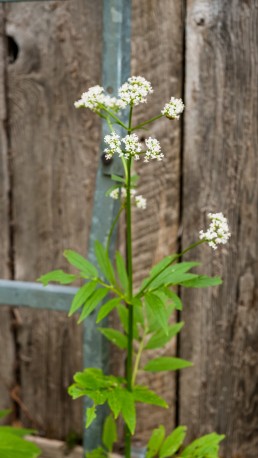
Reference Books:
Holistic Herbal, by David Hoffmann
Pages: 27, 28, 39, 53, 54, 56-60, 62, 65, 70-72, 74, 78, 86, 87, 95, 99, 101, 104, 105, 140, 143-146,159, 186, 194, 108 210, 221, 233, 238, 241
The Way of Herbs, by Michael Tierra
Pages: 12, 20, 26, 32, 34, 36, 202,
The Complete Encyclopedia of Herbs, by Nico Vermeulen
Page: 299
Family Herbal, by Rosemary Gladstar
Pages: 50, 86, 26, 48, 49, 61, 63, 69, 75, 79, 85, 88, 96, 98, 99, 101, 111, 187, 261, 277, 295, 368-70
Peterson Field Guide: Easter/Central Medicinal Plants and Herbs, by Steven Foster and James A. Duke
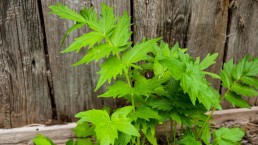
Dandelion: Materia Medica
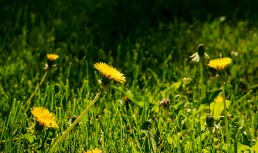
Dandelion
Botanical name: Taraxacum Officinal
Pertinent Information on the Plant
- Alterative (blood purifier)
- Hepatics (having to do with the liver)
- Diuretic (increases urine flow)
- Anti-rheumatics (easing pain of rheumatism and inflammation of joints and muscles)
- Antibilious (helps body remove excess bile and thus aid in cases of biliary and jaundice conditions)
- Laxative (substance that acts to loosen the bowels contents)
- Cholagogues
- General Tonic (liver, blood, kidneys)
- Digestive bitter (improves digestion)
- Varicose veins
- Skin conditions
- Bitter
- Water retention
- Builds energy
- Nervine, high in calcium, iron
- Herpes
- Rashes
- Beats out milk thistle for taking care of liver
- Old name Pissinlct – makes us pee and pee
- Leaf – diuretic (increases urine flow)
- Root – liver – anti-inflammatory
- Good for gas and bloating
- Whole dandelion is good for hypertension
Habitat and Growing area
- Found widespread colouring meadows and waste places in April – May. Dandelion is found here in Ontario on our farm, lawns and disturbed soil
Extra Notes
- Taste is bitter and sweet. Smells earthy, very delicious cup of tea
- Used in many nutritious and digestive tea blends
Reference Books:
Holistic Herbal, by David Hoffmann
Pages: 27, 31, 52, 54, 61, 62, 71, 78, 79, 85, 89, 101, 109, 111, 121, 128, 143-147, 156, 182, 189, 196, 205, 243
The Way of Herbs, by Michael Tierra
Pages: 12, 13, 32, 35, 36, 37, 127-128, 314-315
The Complete Encyclopedia of Herbs, by Nico Vermeulen
Page: 285
Family Herbal, by Rosemary Gladstar
Pages: 19, 25, 28, 32, 51, 55, 78, 85, 91, 94, 100, 102, 105, 189, 193, 200, 201, 203, 206, 218, 219, 221, 227, 255, 256, 263, 277, 326-27
Peterson Field Guide: Easter/Central Medicinal Plants and Herbs, by Steven Foster and James A. Duke
Pages: 145, 146
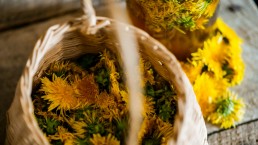
Motherwort: Materia Medica
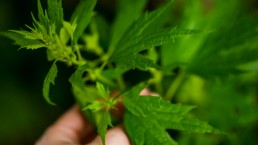
Motherwort
Botanical name: Leonorus cardiaca
Pertinent Information on the Plant
- Emmenagogue (agent that regulates and induces normal menstruation)
- Suppressed menstruation
- Female disorders
- Relieving menstruation cramps
- Menopause (water retention, hot flashes, M=mood swings)
- Aids in child birth
- Heart tonic
- Heart palpitations
- Add to cough formula when someone has bad heart
- Add to asthma formula when someone has a bad heart
- Nervine relaxant (calm nervous tension and nourish the nervous system)
- Sedative (exerts a soothing, tranquilizing effect on the body)
- Antispasmodic (calming nervous and muscular spasms or convulsions)
- Hepatic (having to do with the liver)
- May be used to alleviate false labor pains
- Diuretic (increases flow of urine)
- Carminative (causing the release of stomach or intestinal gas)
- Antioxidant (prevents or inhibits oxidation)
- Fevers
- Stomach aches
Habitat and Growing area
- Found on our farm in Ontario Canada
- Likes to grow in disturbed ground; pasture land and fence line
Extra Notes
- A beautiful addition to heart tonic tea and menstruation teas
Reference Books:
Holistic Herbal, by David Hoffmann
Pages: 26, 27, 28, 38, 39, 65, 78. 99, 101, 104, 144-147, 183, 215
The Way of Herbs, by Michael Tierra
Pages: 158-159
The Complete Encyclopedia of Herbs, by Nico Vermeulen
Pages: 168
Family Herbal, by Rosemary Gladstar
Pages: 203, 205, 228, 261, 295, 350
Peterson Field Guide: Easter/Central Medicinal Plants and Herbs, by Steven Foster and James A. Duke
Pages: 182, 183

